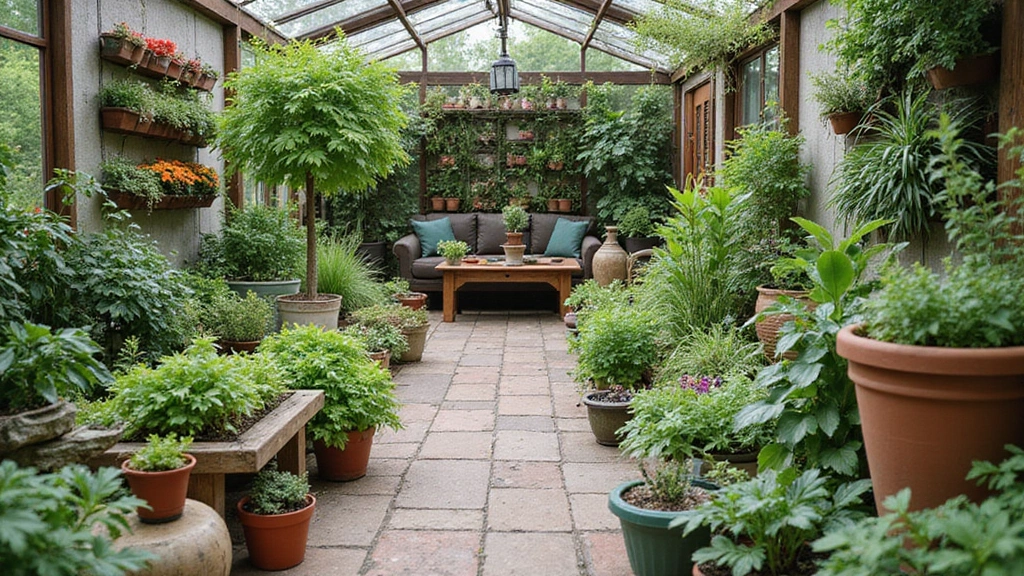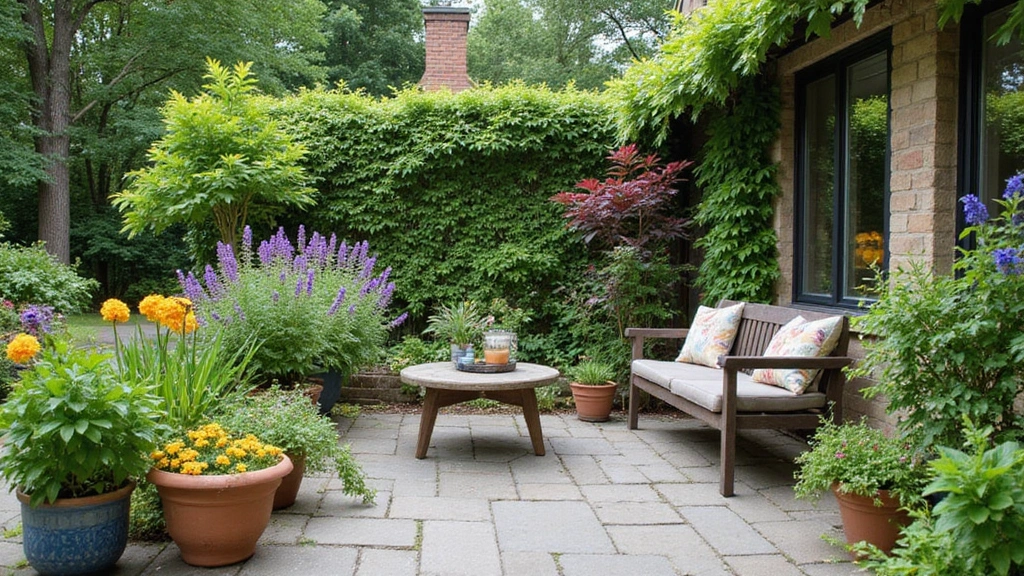Having a small garden doesn’t mean you have to settle for less beauty or productivity. With creative planning and clever designs, your outdoor space can flourish with plants, flowers, and seasonal vegetables. This listicle will inspire you with unique ideas that make the most of every inch of your garden, offering tips for seasonal gardening that keep your space vibrant year-round. Get ready to transform your small garden into a lush oasis that showcases your personal style and provides delicious rewards.
From vertical gardens to container planting, each idea is tailored for compact spaces but is packed with potential. You’ll discover how to integrate beautiful decor and functional features, ensuring your garden is both stunning and practical. Let’s explore these 28 ideas that will help you maximize your outdoor space and immerse yourself in the joys of gardening!
1. Vertical Gardens: Grow Up, Not Out
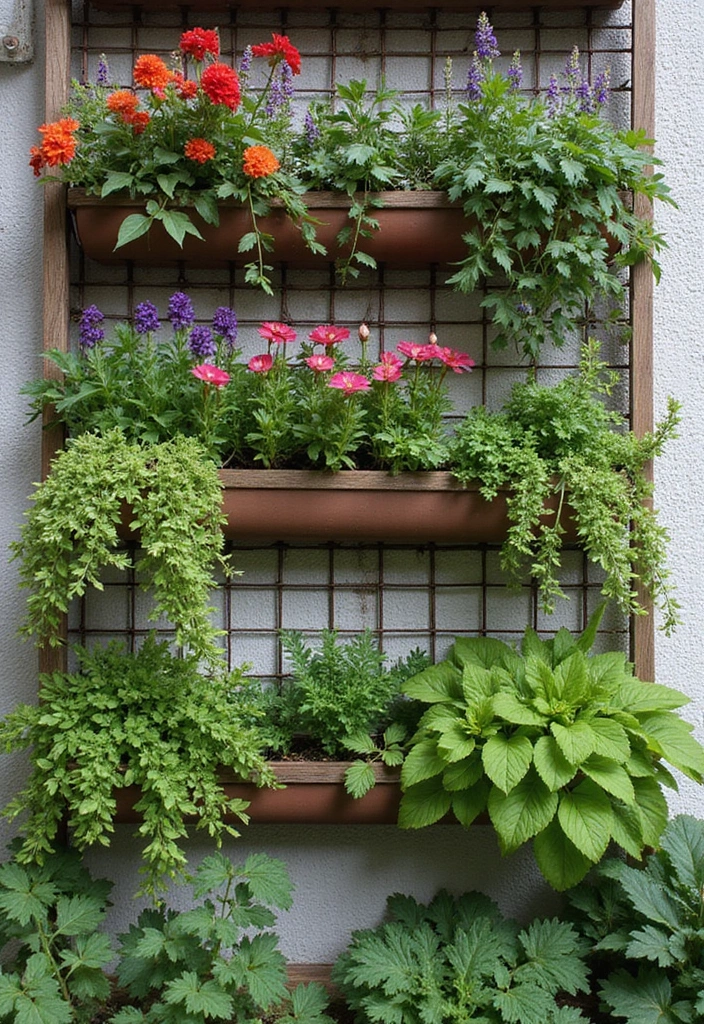
When floor space is limited, think vertically! Vertical gardens allow you to grow a variety of plants in a small footprint. You can use trellises, wall planters, or even hanging pots to create a stunning display. Not only do they make a striking visual impact, but they also allow for better air circulation and sunlight exposure.
Consider using herbs like basil and mint, which thrive well in vertical setups. Incorporate colorful flowers for a burst of joy or even seasonal vegetables like cherry tomatoes. A great option for getting started is the Mr. Stacky 5 Tier Stackable Strawberry, Herb, Flower, and Vegetable Planter, perfect for maximizing vertical space while keeping your plants organized.
Remember to choose a mix of plants with varying growth habits to add depth to your garden. Using a sturdy structure is crucial—consider the RUBFAC Metal Garden Arch, which provides the support needed for climbing plants like roses and vines, enhancing both functionality and aesthetics.
Gardening Tips:
– Ensure your vertical structure is sturdy enough to support the weight of your plants.
– Group plants with similar water and sunlight needs together.
– Use lightweight soils to keep your vertical garden from becoming too heavy. The Back to the Roots 100% Organic Indoor Potting Mix is an excellent choice, promoting healthy growth while keeping the overall weight manageable.
With these tips and the right products, your vertical garden can be a vibrant and productive space in no time!
When garden space is tight, remember: growing up is the new growing out! Embrace vertical gardens to enrich your outdoor experience and transform small areas into lush, vibrant displays.
2. Container Planting: Flexibility at Its Best
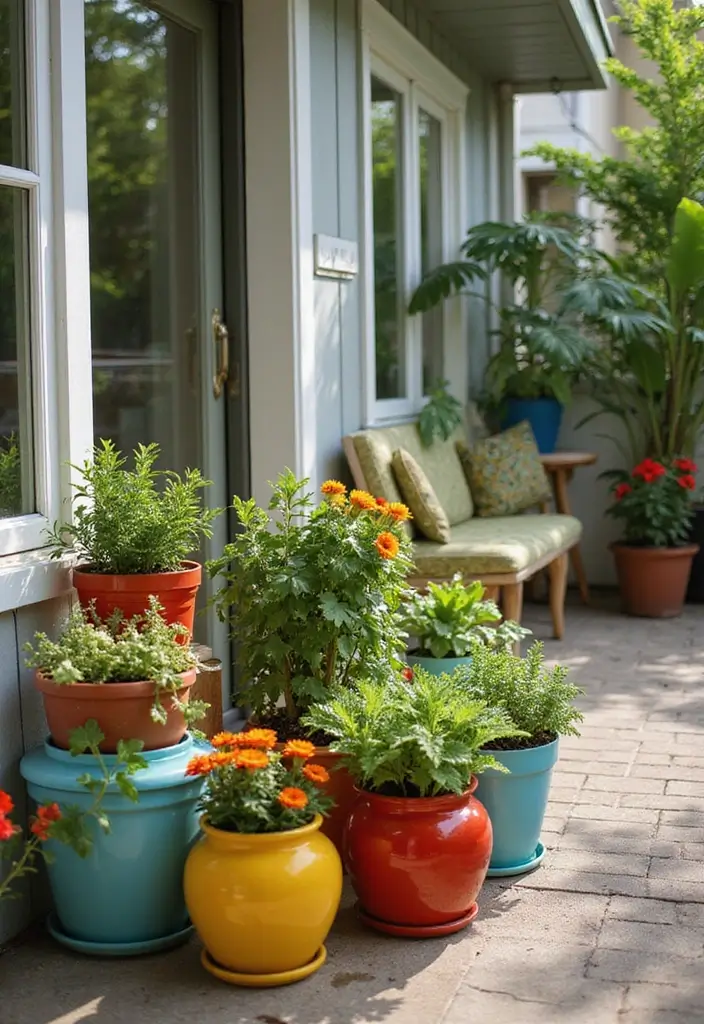
Container gardening is perfect for small spaces because it offers flexibility and creativity. You can place pots on patios, balconies, or even windowsills. With an array of containers available, from ceramic to fabric pots, you can mix and match styles to complement your home’s decor. For instance, consider using decorative plant pots like the Gepege 6 Inch Beaded Ceramic Planter Set, which features drainage holes and saucers – essential for healthy plant growth.
Fill your containers with seasonal vegetables such as peppers, lettuce, or even strawberries for a sweet treat. With the right soil, like high-quality potting soil from Miracle-Gro, you can ensure your plants thrive. This potting mix is designed for container plants, flowers, and vegetables, feeding them for up to six months.
Don’t forget about flowers; marigolds and petunias can add color and attract pollinators to your garden. Just remember to choose containers with drainage holes, like the self-watering planters available for convenience. Check out the self-watering planter set, which comes in various sizes and helps prevent overwatering by maintaining optimal moisture levels.
Container gardening gives you the freedom to change your garden layout whenever you want, keeping your space lively and inviting.
3. Edible Landscapes: Beauty Meets Function
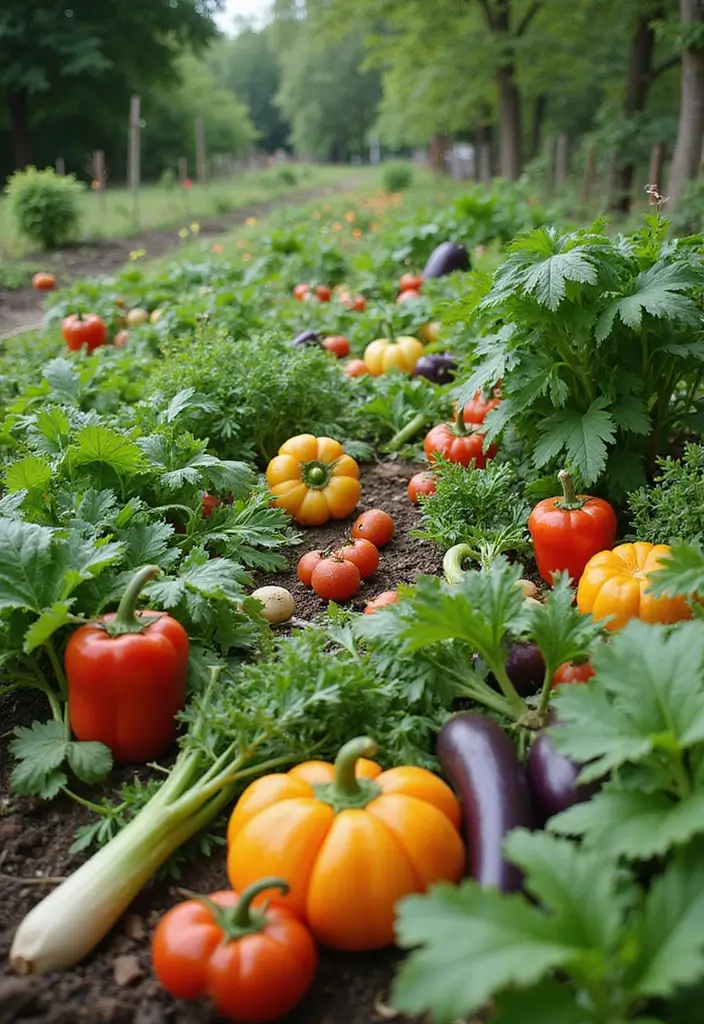
Combine aesthetics and functionality by creating an edible landscape. Imagine a garden where kale and chard are as beautiful as your favorite flowers! By integrating colorful vegetables and herbs into your landscaping, you can maximize your outdoor space and enjoy the benefits of fresh produce.
To get started, you might consider using a raised garden bed kit to create defined spaces for your fruits and vegetables. These galvanized planter boxes not only look great but also offer excellent drainage and soil control, making them perfect for growing a variety of edible plants.
For planting, having an assortment of seeds is essential. The organic vegetable seeds variety pack provides you with a diverse selection of herb, fruit, and vegetable seeds that are guaranteed to grow. This variety will allow you to mix colorful edible flowers, like nasturtiums, with your vegetables, enhancing the beauty of your garden while ensuring a bountiful harvest.
Additionally, effective gardening requires the right tools. A garden tool set can make a significant difference in how you approach your gardening tasks. This heavy-duty set includes everything you need for planting, maintaining, and harvesting your edible landscape, making the process more enjoyable and efficient.
Remember these gardening tips to make the most of your edible landscape:
– Pay attention to plant heights for a balanced look; taller vegetables should be at the back of beds.
– Mix in flowering plants to attract beneficial insects.
– Plan for seasonal rotations to keep your garden productive throughout the year.
Enjoy the beauty and reward of edible landscapes, where every meal can be a celebration of your gardening efforts!
4. Create a Cozy Seating Area
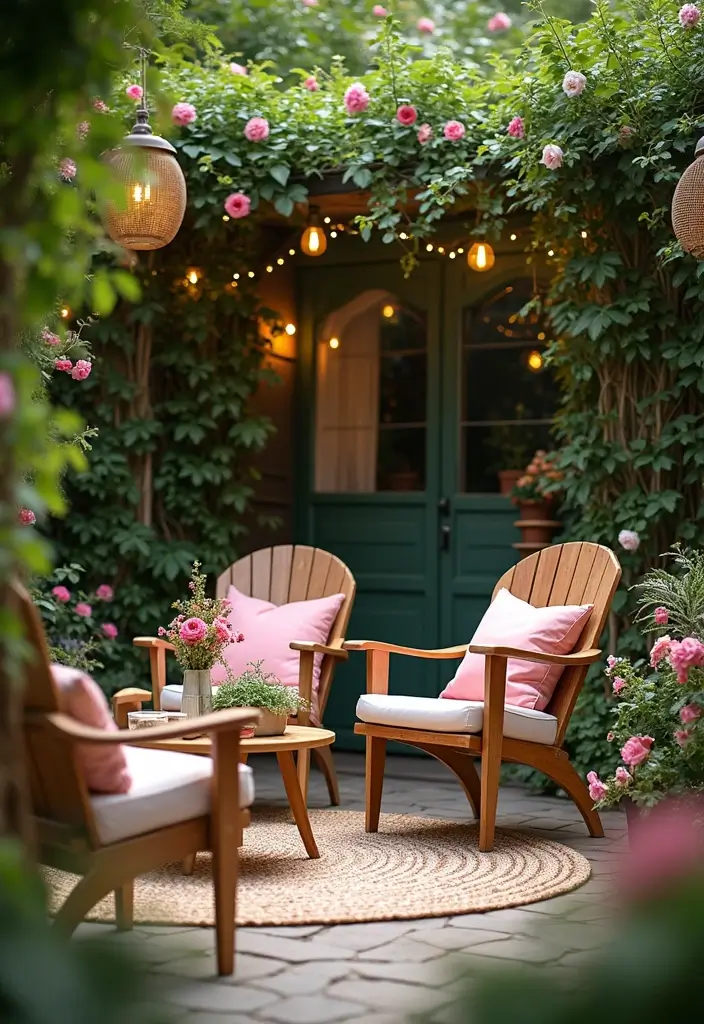
Transform a small corner of your garden into a cozy seating area where you can relax and enjoy the fruits of your labor. Use simple chairs or benches surrounded by fragrant flowers and lush greenery, and consider adding comfortable cushions like these outdoor cushions to make your space even more inviting.
Incorporate outdoor string lights to create a magical ambiance for evening gatherings. These lights not only enhance the atmosphere but also allow you to enjoy your garden long after the sun sets. You could also build a small fire pit, such as the portable fire pit, for cool evenings, making your garden a year-round retreat.
Gardening Tips:
– Choose a spot with good sunlight for daytime relaxation.
– Consider using potted plants to create privacy and lushness around your seating area.
– Use pathways or stepping stones to guide guests to your serene hideaway.
Creating a cozy seating area allows you to fully appreciate your small garden, making it a perfect spot to unwind with a book or enjoy a cup of tea.
5. Herb Spirals: A Creative Twist
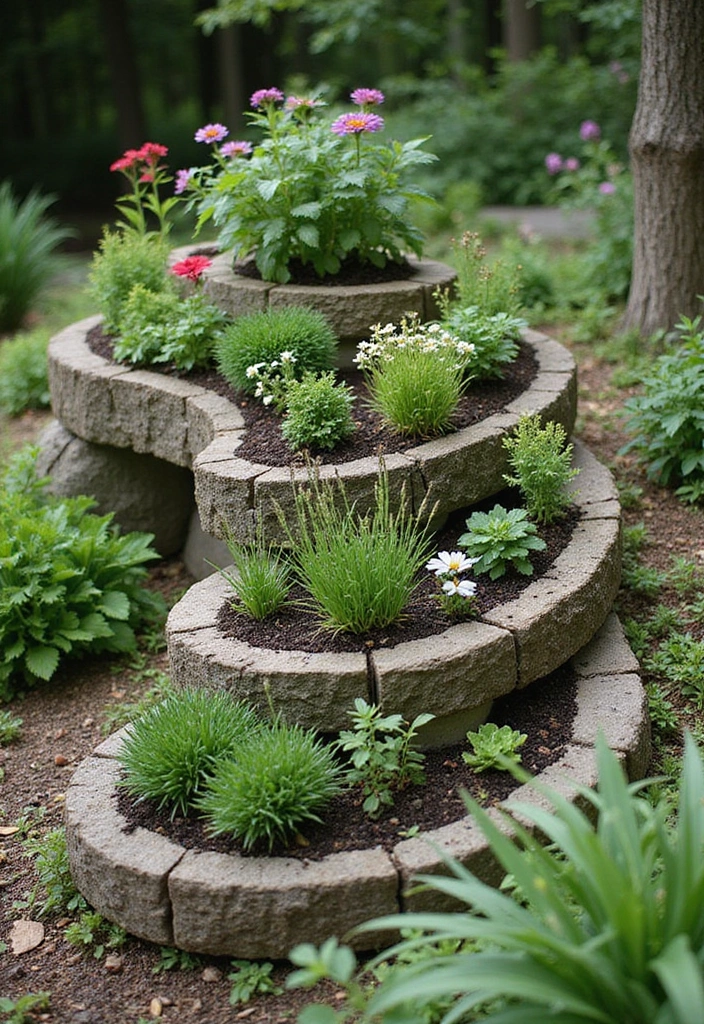
An herb spiral is not only a stunning focal point but also maximizes space effectively. This design utilizes a vertical spiral structure to create different microclimates for your herbs. The higher sections get more sun, while the lower sections retain moisture, catering to various plant needs.
It’s a fantastic project for small gardens, accommodating a wide range of herbs like rosemary, thyme, and parsley. You can even incorporate some flowers for aesthetics and to attract pollinators.
To get started, consider using a garden spiral planter kit. This stackable planter allows you to create your own spiral garden easily, making the most of your available space.
When selecting herbs, using a organic herb seeds variety pack can provide you with a diverse selection of options. This pack includes seeds for popular herbs like basil, cilantro, and parsley, perfect for your spiral.
Additionally, monitoring the moisture levels in your soil is crucial. An garden soil moisture meter can help you keep an eye on your spiral’s drainage, ensuring your herbs do not become waterlogged.
With an herb spiral, you can cultivate fresh flavors right at your fingertips while adding an artistic touch to your garden.
6. Garden Borders: Define Your Space
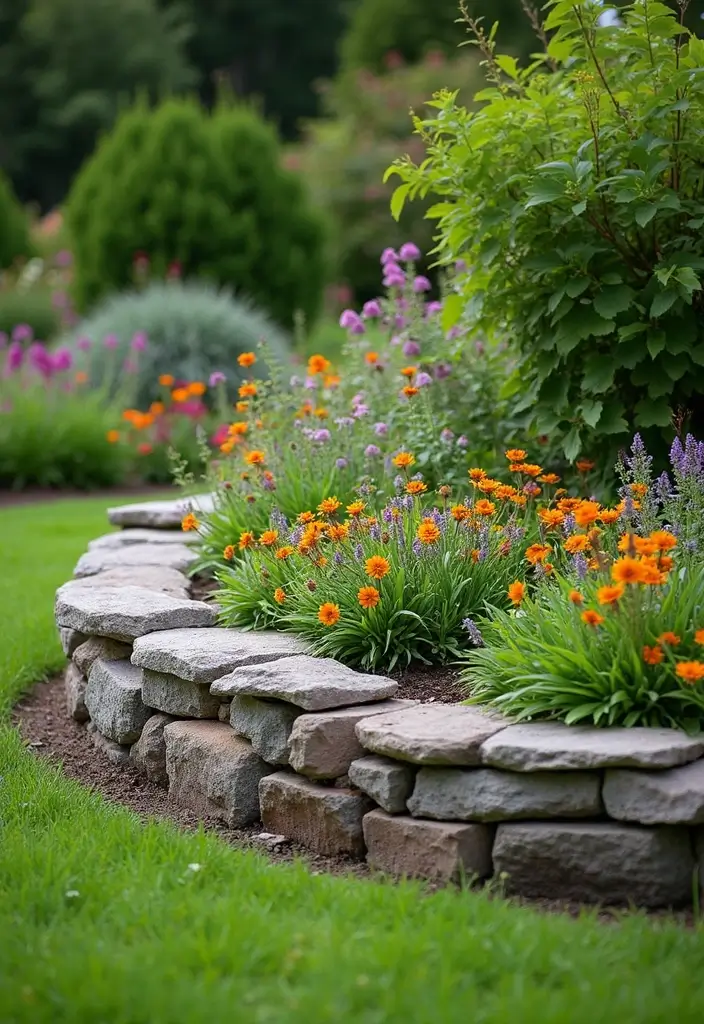
Utilizing garden borders is a clever way to segment your small space visually. Borders can be created using different materials like terracotta, wood, or even stone, offering structure to your garden. They not only define paths but also help keep plants organized.
For a charming terracotta finish, consider the terracotta garden border edging, which comes as a set of 10 interlocking lawn stakes. This product provides an easy and attractive way to outline your flower beds.
Incorporating options like the wooden garden border edging can enhance the rustic appeal of your garden. With 3 picket panels in a pack, this wooden fence border creates a beautiful barrier for your plants while complementing the natural surroundings.
If you’re looking for a stone look without the heavy lifting, stone garden border edging offers a no-dig solution. This 15-foot kit not only defines the space effectively but also adds a decorative touch with its slate gray finish.
Fill the borders with seasonal flowers and plants to add pops of color and texture. When planning, consider using low-maintenance perennials or shrubs that will provide year-round interest.
Gardening Tips:
– Use borders to create raised beds, which can make gardening easier on your back.
– Incorporate paths or stepping stones for easy access.
– Plant taller flowers at the back and shorter ones in front for a tiered effect.
Making effective use of garden borders can enhance the look of your small garden while keeping it organized and functional.
7. Use Colorful Mulch: Style and Function

Mulch does more than just suppress weeds; it adds color and texture to your garden! Using colorful mulch can enhance the visual appeal of your small garden while providing essential benefits such as moisture retention and temperature regulation.
You can find various mulch types, including wood chips, straw, or even dyed options in vibrant shades. For instance, consider Raging Red Colored Wood Chip Mulch, which not only beautifies your garden with its striking color but also serves the practical purpose of weed suppression and moisture retention. Choose colors that complement the plants you have, creating a cohesive look.
If you prefer an organic option, check out Back to the Roots Organic Premium Mulch. Made from natural materials, this mulch will improve soil health over time while adding a rustic charm to your garden.
Gardening Tips:
– Apply a layer of 2-4 inches of mulch for optimal benefits.
– Replenish mulch yearly to maintain its appearance and effectiveness.
– Consider using organic mulch, which will improve soil health over time.
For those looking to make the application of mulch easier, a VEVOR Mulch Spreader can be a great tool. With its adjustable handle and wide spreader, it simplifies the process of distributing mulch evenly across your garden beds.
Colorful mulch can tie your garden together, adding a polished look while assisting in plant health.
8. Seasonal Planting: A Year-Round Garden

Maximize your garden’s potential by practicing seasonal planting. By selecting plants suited for each season, you can ensure your garden remains vibrant and productive throughout the year. This approach allows you to enjoy a variety of colors and harvests as the seasons change.
Start with spring vegetables like peas and lettuce, followed by summer staples like tomatoes and zucchini. In the fall, consider planting root vegetables such as carrots or turnips. Finally, winter gardens can include hardy greens like kale.
To help you stay organized, consider using Clyde’s Garden Planner – Vegetable Planting Slide Chart. This handy garden planting calendar will assist you in keeping track of optimal planting times for each crop, ensuring you make the most of your seasonal plantings.
Additionally, it’s important to rotate your crops to maintain soil health and prevent pests. An Allotment Crop Rotation Planner could be a useful tool for this purpose, helping you manage your planting schedule effectively.
If you’re looking to extend your growing season, consider setting up a cold frame. The Firwood Garden Greenhouse Portable Wooden Cold Frame is a great option. It allows you to protect your plants from colder temperatures while creating a conducive environment for growth.
Seasonal planting keeps your garden dynamic and ensures you get the most out of your small outdoor space.
9. Miniature Fruit Trees: Small Yet Sweet
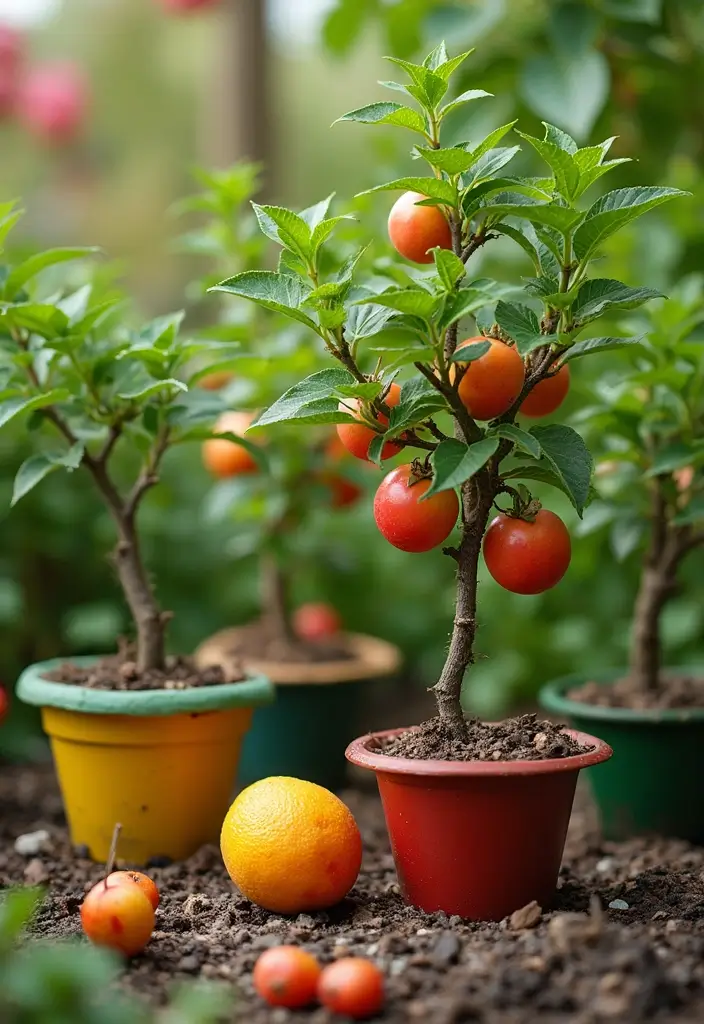
Bring a touch of charm to your small garden with miniature fruit trees! These dwarf varieties are perfect for tight spaces, yet they still produce delicious fruits. Imagine picking fresh lemons or figs right from your balcony.
Miniature trees can be planted in large pots or directly in your garden. Depending on your climate, consider varieties like the Garden State Bulb Meyer Lemon Tree or the TriStar Plants – Gala Apple Tree. Not only will they produce fruits, but they also add beauty and structure to your space.
Gardening Tips:
– Choose pots that are at least 14-18 inches deep to accommodate root growth. For this, consider using large plant pots for trees like the Classic Home and Garden Shaina Planting Pots, which are lightweight and UV-resistant, making them suitable for both indoor and outdoor use.
– Regularly prune your trees to maintain their size and shape.
– Ensure they receive enough sunlight, typically 6-8 hours a day.
Miniature fruit trees can provide both a productive yield and a delightful aesthetic to your garden, enhancing your outdoor space beautifully.
10. Raised Garden Beds: Efficient and Accessible
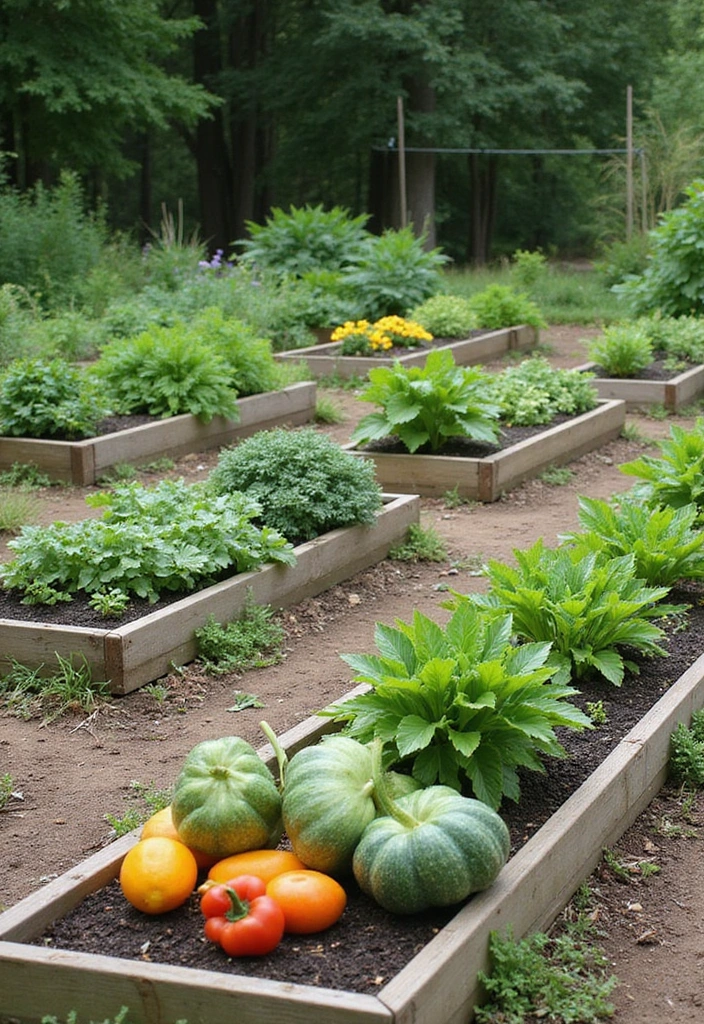
Raised garden beds are an excellent solution for small gardens, offering easy access and better soil quality. They can be built at various heights to accommodate different gardening styles, making them accessible for everyone.
To start, consider using a raised garden bed kit. This galvanized planter kit provides a sturdy structure that can withstand the elements while allowing you to create a designated space for your vegetables and herbs.
Fill your raised beds with nutrient-rich soil by choosing a quality mix like organic potting soil mix. This premium blend is ideal for growing a diverse range of seasonal vegetables, ensuring your plants receive the necessary nutrients for robust growth.
Additionally, having the right tools is essential for maintaining your garden. A garden tool set with ergonomic handles will make planting, weeding, and harvesting much easier, allowing you to engage in your gardening tasks comfortably.
These raised beds provide better drainage and can warm up quicker in the spring, extending your growing season.
Gardening Tips:
– Incorporate a mix of soils and compost for optimal plant growth.
– Use native materials or recycled wood to build your beds sustainably.
– Plan your layout to ensure you can reach all areas easily.
By utilizing raised garden beds, along with these helpful products, you create a functional and attractive space that simplifies the gardening process.
11. Hanging Gardens: Elevate Your Greenery
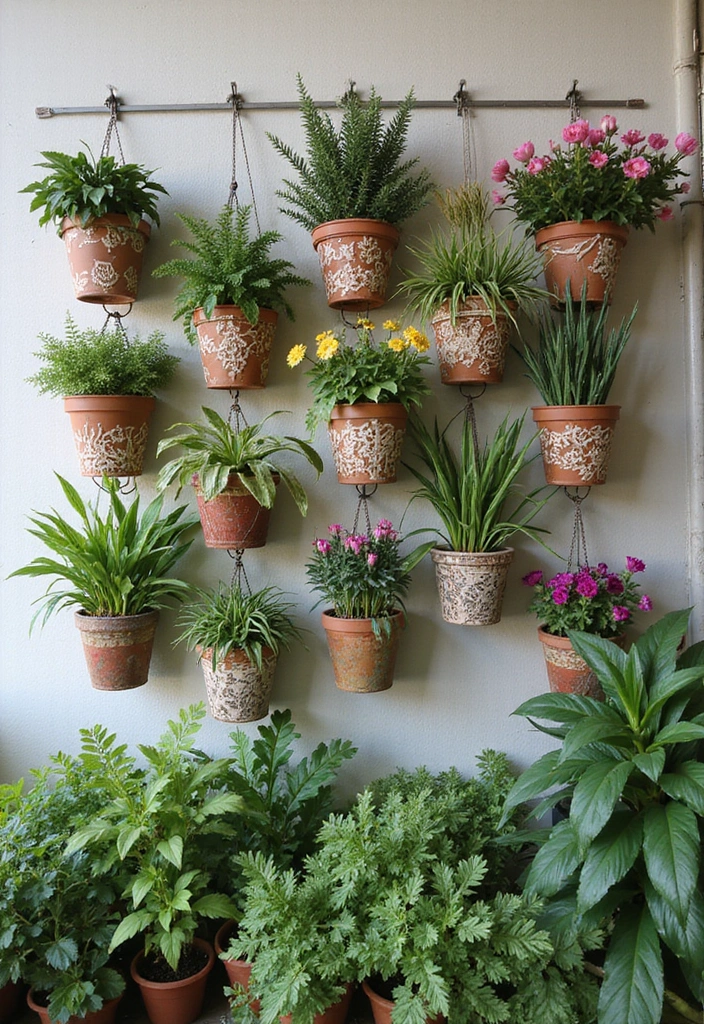
Hanging gardens are not just trendy; they’re incredibly functional for small spaces! You can create beautiful vertical displays using wall-mounted planters like the PlantPod Luxe – Self-Watering Wall Planters, which are easy to water and install, allowing you to design your own vertical garden. These stylish planters draw the eye upward and can be filled with trailing plants, herbs, or even seasonal flowers.
To further enhance your setup, consider adding hanging pots such as the Melphoe 2 Pack Self Watering Hanging Planters. These pots come with drainage holes and hooks, ensuring that your plants thrive while adding a touch of greenery to your space. Use hooks and brackets, like the ceiling hooks for hanging plants, to secure pots at different heights for a dynamic look. This setup not only saves ground space but also transforms walls and ceilings into livable green areas.
Gardening Tips:
– Ensure your hanging planters have good drainage to avoid overwatering.
– Select lightweight pots to prevent any strain on hanging hooks.
– Choose plants that thrive in the specific light conditions of your hanging location.
With hanging gardens, not only do you add style, but you also create a unique opportunity to grow plants in limited space.
With a hanging garden, you can turn any wall into a vibrant tapestry of greenery, maximizing your small garden ideas while saving precious ground space. Elevate your outdoor space—literally!
12. Garden Arches: Add Height and Beauty
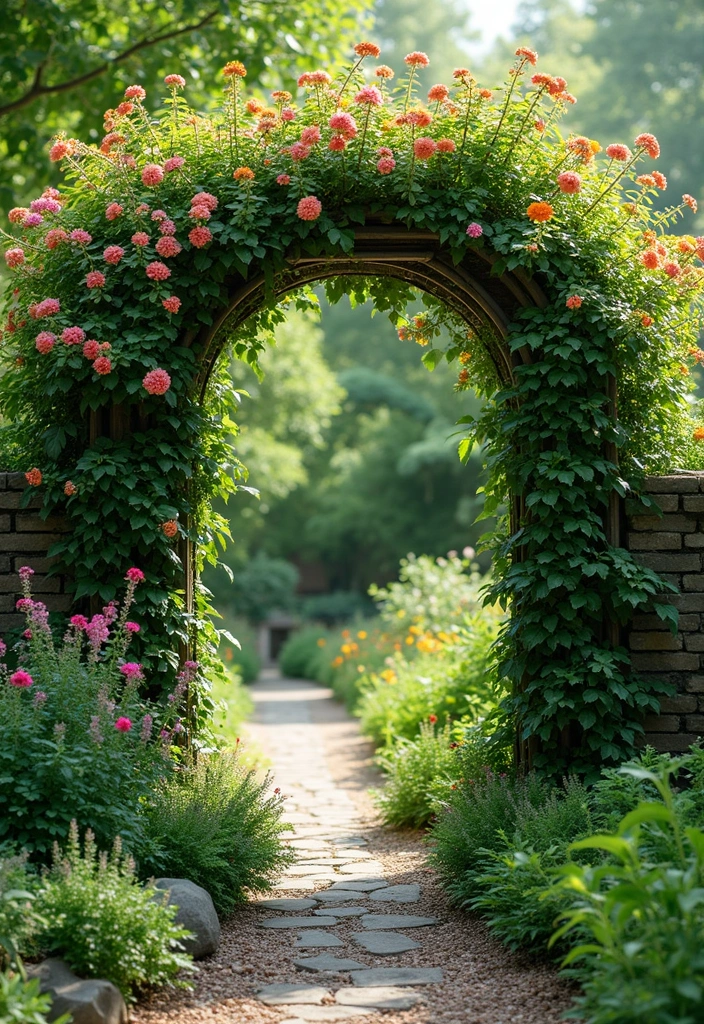
Garden arches are a fantastic way to add height and structure to your small space. They create a focal point while serving as a support for climbing plants like jasmine or sweet peas. By incorporating products such as RUBFAC metal garden arch, you can easily create a stunning entryway into your garden or a serene pathway for relaxation.
Covering your arch with fragrant climbing plants will create shaded areas that are perfect for unwinding. Consider using climbing plant seeds (jasmine or sweet peas) to enhance your garden’s beauty and fragrance. These plants will not only beautify the arch but also provide a lovely aroma, making your outdoor space inviting.
Additionally, you can elevate the atmosphere of your garden at night by incorporating outdoor string lights. These lights will add a magical touch and create a warm ambiance, perfect for evening gatherings or quiet moments under the stars.
Garden arches not only enhance the visual appeal of your space but also create functional areas for enjoyment. With sturdy materials for your arch, early training of your climbing plants, and the glow of string lights, you can transform your small garden into a beautiful oasis.
13. Succulent Displays: Low-Maintenance Charm
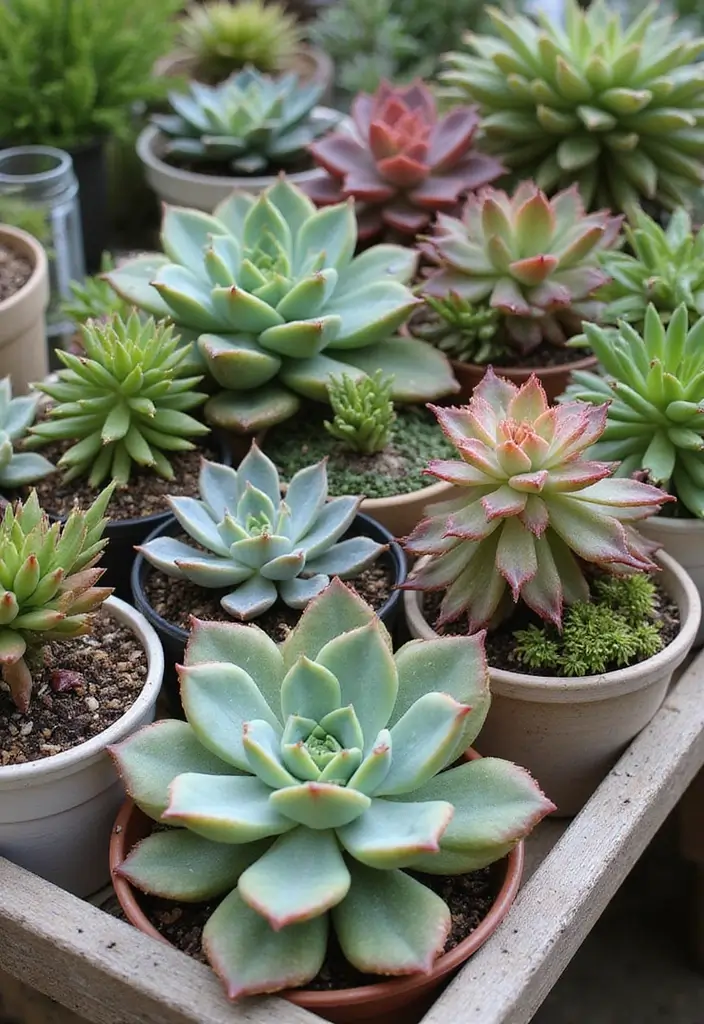
Succulents are the perfect solution for those seeking a low-maintenance gardening option. These hardy plants come in various shapes and colors, making them an excellent choice for small gardens. You can create stunning displays in pots, terrariums, or even vertical walls. To get started, consider using Back to the Roots 100% Organic Succulent & Cacti Mix, which provides premium nutrition for both indoor and outdoor plants, ensuring your succulents thrive.
Group different varieties together to form visually appealing arrangements in decorative containers like the NWFashion Special Design Fun Garden Flower Planter. This 6-inch planter not only adds charm to your garden but also allows for proper drainage, essential for preventing root rot.
Succulents require minimal watering and can thrive in almost any light condition, making them a versatile option. To maximize your small space, you might want to consider vertical gardening. The PlantPod Luxe – Self-Watering Wall Planters are an excellent choice for creating a vertical garden. This set of six planters is easy to install and water, providing an attractive way to showcase your succulents while saving space.
Gardening tips:
– Use well-draining soil and pots, like the succulent soil mix mentioned earlier, to prevent root rot.
– Place your succulent arrangements where they can soak up sunlight.
– Rotate your plants regularly to maintain their shape and growth.
With succulents, your small garden can be a vibrant showcase of low-maintenance beauty that offers endless design possibilities.
14. Playful Pathways: Guide with Style

Create playful pathways in your small garden to guide visitors through your space while adding charm and character. Using options like stepping stones, gravel, or natural wood chips can help define paths that lead through your lush greenery. This not only makes your garden more navigable but also elevates its aesthetic appeal.
Consider curvy paths that mimic natural trails, providing an organic feel to your garden. You can enhance the whimsical touch by planting colorful flowers along the sides of your pathways.
Gardening Tips:
– Ensure paths are designed for easy maintenance and access to garden beds.
– Use natural materials like natural wood chips for a cohesive look with your plants.
– Consider installing garden path lighting along paths for nighttime visibility.
Playful pathways can transform a small garden into an enchanting space that invites exploration.
15. Garden Labels: Organize with Style
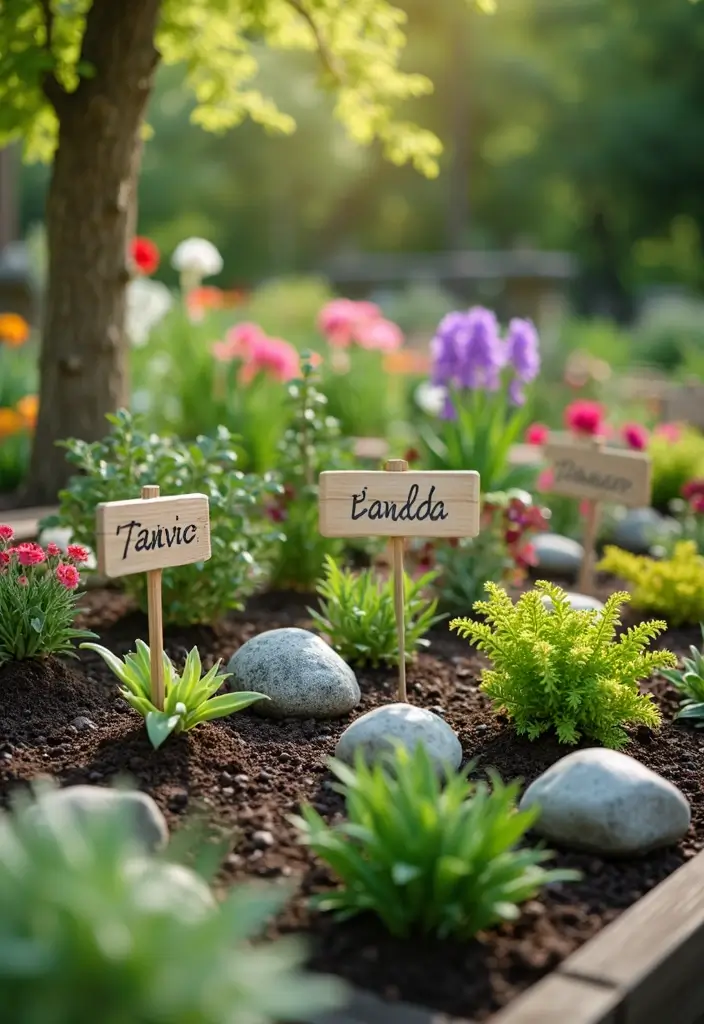
Organizing your small garden can be both practical and stylish with unique garden labels. Whether you opt for painted stones, wooden sticks, or decorative signs, labeling your plants helps you keep track of what’s growing where. This is especially beneficial for seasonal vegetables that might slip your mind!
For a weatherproof solution, consider the weatherproof garden labels. These permanent markers are UV fade resistant and designed for outdoor use, ensuring they stand up to the elements while clearly marking your plants.
If you prefer a more decorative touch, the decorative plant markers are a wonderful option. This set comes with eco-friendly bamboo labels and a marker pen, perfect for adding an aesthetic flair to your garden while helping you keep everything organized.
For those who enjoy a bit of DIY, the DIY garden label kit is an excellent choice. With 100 waterproof plant tags included, you can easily identify seedlings, flowers, and vegetables as your garden changes throughout the seasons.
Mixing up label styles can create an eclectic look in your garden, while regularly updating your labels will help you stay organized as the seasons change. Garden labels provide both organization and charm to your small space, making gardening even more enjoyable.
16. Low-Growing Ground Covers: Fill Open Spaces
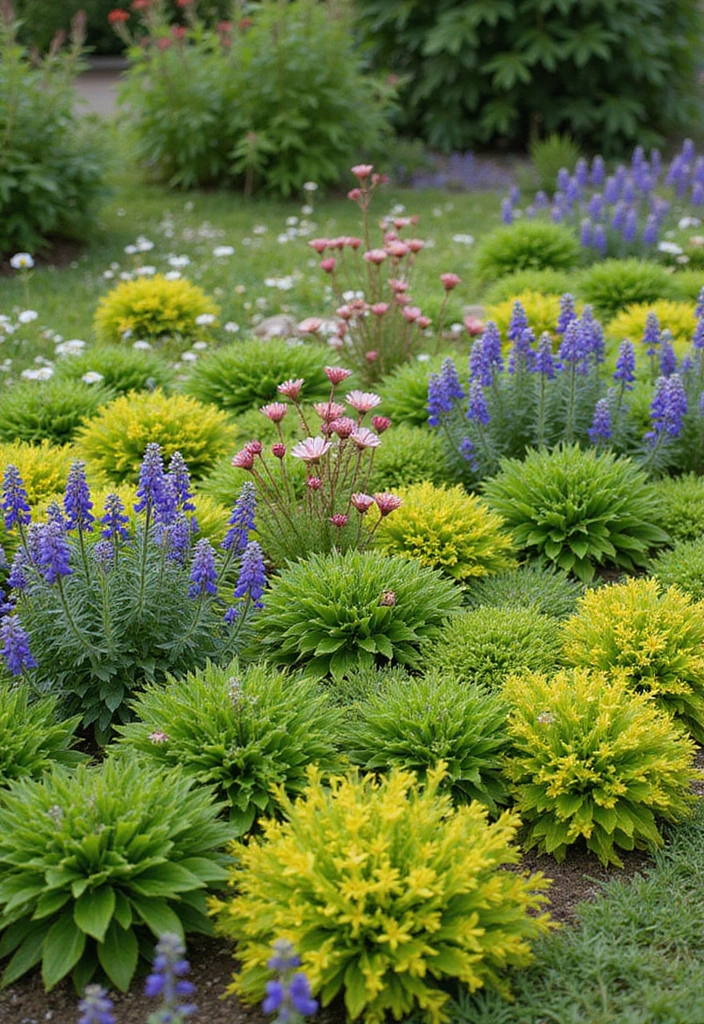
Using low-growing ground covers is an excellent strategy for filling open spaces in your small garden while preventing weeds. Varieties like creeping thyme seeds or sedum plant varieties can add lush greenery and color without taking up much vertical space.
These plants thrive in various conditions and can also provide stunning flowers throughout the growing season. By incorporating ground covers, you’ll create a cohesive look in your garden while promoting healthy soil. The creeping thyme not only offers beautiful purple flowers but also attracts pollinators, enhancing the biodiversity of your garden. Meanwhile, the sedum, known for its drought resistance, can thrive in rock gardens or other challenging areas, ensuring your garden is both beautiful and resilient.
To maintain your ground covers effectively, consider using garden pruning shears. These shears feature a sharp, rust-resistant steel blade that makes it easy to trim back your ground covers, maintaining the desired height and preventing them from encroaching on other plants. Regular trimming will help keep your garden looking tidy and well-cared-for.
Gardening Tips:
– Choose ground covers that suit your climate and soil conditions.
– Regularly trim to maintain desired height and prevent encroachment on other plants.
– Mix different ground cover varieties for added texture and interest.
Ground covers can stitch your garden together, offering a rich tapestry of plants that thrive together.
17. Garden Crafting: Add Personal Touches
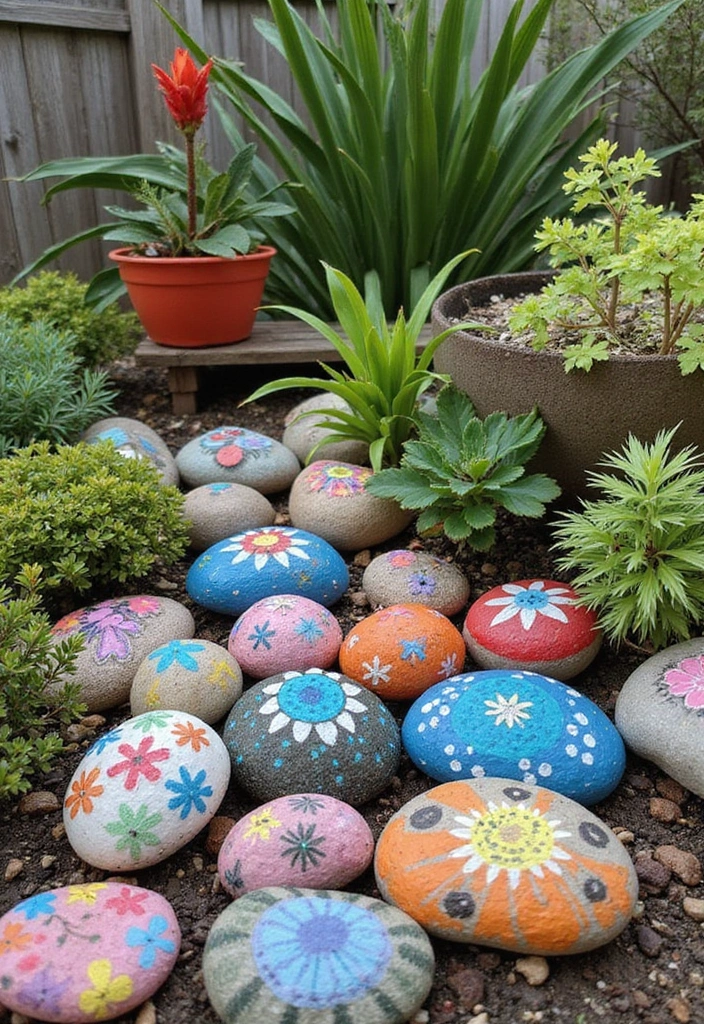
Incorporate DIY crafts into your small garden to create personalized decor that reflects your style. From painted rocks to homemade bird feeders, crafting helps make your space uniquely yours. You can involve your family in these projects, turning gardening into a fun and creative activity.
For instance, consider using weather-resistant craft paint to transform ordinary rocks into colorful garden markers or decorative accents. This set comes with 25 colors and brushes, perfect for letting your creativity flow.
Additionally, creating a mosaic pathway using colorful tiles can be a delightful project. The mosaic tile set offers 1050 mixed shapes that can add an artistic flair to your garden, turning it into a joyful place to gather.
Don’t forget about the birds! Engaging children or friends in making a bird feeder can be a rewarding experience. The bird feeder kit comes with paints, a brush, and an educational journal, making it ideal for fostering a love of nature while crafting.
These crafts not only enhance your outdoor space but also foster community spirit and creativity. Remember to use weather-resistant materials to ensure your creations withstand the elements, and let your imagination run wild—there are no strict rules in garden crafting!
18. Wildlife-Friendly Spaces: Embrace Nature
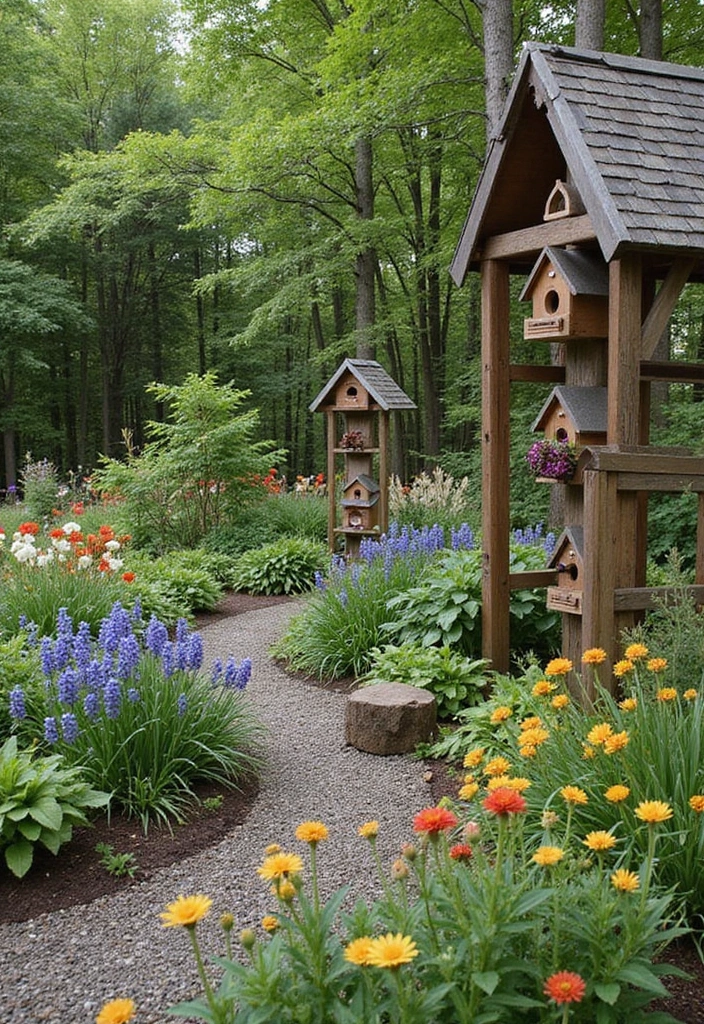
Create a small garden that welcomes wildlife by cultivating a space that attracts beneficial creatures. Planting native flowers and shrubs provides food and shelter for butterflies, bees, and birds, enhancing the ecosystem while adding vibrancy to your garden.
To encourage wildlife to visit, consider incorporating a birdhouse with a 1-1/2″ entrance hole. This simple addition offers a safe nesting spot for various bird species, enriching your garden with their songs and activities. Additionally, a bee hotel serves as a handcrafted wooden habitat designed to attract pollinators. By providing shelter for bees and other beneficial insects, you’re supporting the vital role they play in your garden’s health.
Incorporating a small water feature, such as the Homedics tabletop water fountain, can further enhance your wildlife-friendly space. The soothing sound of flowing water not only creates a calming atmosphere but also attracts birds and other creatures looking for hydration, encouraging them to visit your garden.
Observing these creatures can greatly enhance your gardening experience and foster a stronger connection to nature.
Gardening Tips:
– Choose plants that bloom at different times to provide food throughout the seasons.
– Avoid pesticides that can harm beneficial insects.
– Maintain a small area of natural growth to promote habitat.
By embracing wildlife in your small garden, you’ll cultivate a dynamic ecosystem and a lively outdoor experience.
Invite nature to your small garden! Plant native flowers, add birdhouses, and watch your outdoor space come alive with vibrant wildlife. A thriving ecosystem adds beauty and joy to your gardening experience.
19. Creative Fencing: Define Your Space
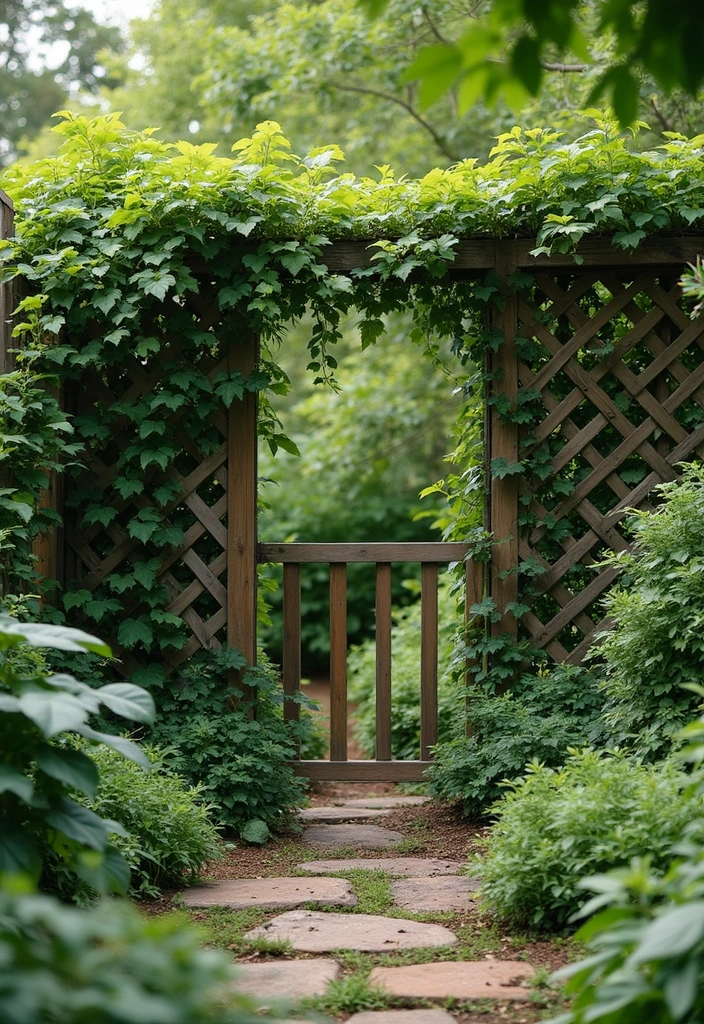
Fencing doesn’t have to be plain! Use creative fencing to both define your garden and showcase your style. Options like lattice fence panels, bamboo, or even repurposed wood create a beautiful boundary while allowing sunlight and air to flow through. The bamboo fencing roll can add a natural look to your outdoor space, providing an attractive yet functional screen that blends seamlessly with your garden ambiance.
Consider incorporating trellises or climbing plants along your fence to add greenery and charm. A great option is the garden trellis for climbing plants, which not only supports vines and roses but also enhances privacy while creating a stunning visual display.
Gardening Tips:
– Choose fencing materials that complement your home’s architecture.
– Allow climbing plants to grow on the fence for added beauty and coverage.
– Regularly maintain your fence to keep it looking fresh.
Creative fencing can transform the look of your small garden while serving practical purposes, making your outdoor space feel more inviting and well-defined.
20. Sunflowers: Cheerful Highlights
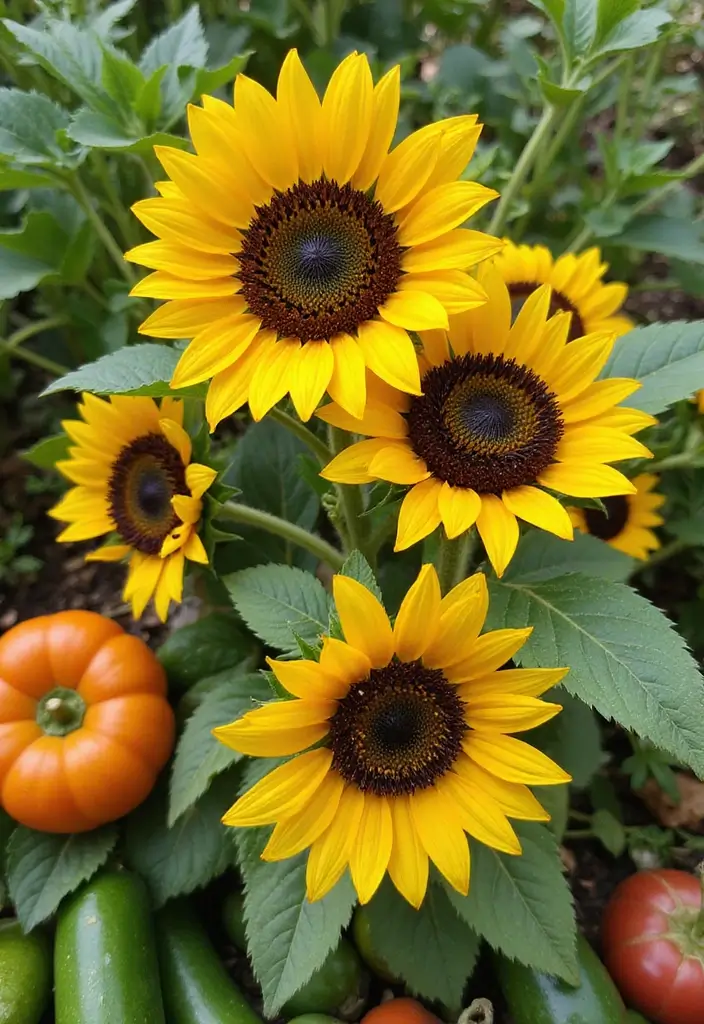
Brighten your small garden with sunflowers—they’re cheerful, easy to grow, and provide a stunning visual impact! These tall beauties can create a dramatic backdrop or act as focal points in your garden beds. Plant them alongside seasonal vegetables for added charm and color.
Sunflowers attract beneficial pollinators, making them a perfect addition to support your garden’s health. They also produce seeds that can be harvested for snacks or bird food.
To ensure you get the most out of your sunflower planting, consider using a garden soil moisture meter to keep track of soil hydration, especially during their critical growing stages. This handy tool will help you maintain the right moisture levels, leading to healthier plants.
If space is limited, opt for dwarf varieties like those found in the dwarf sunflower seeds package, which is perfect for small gardens. These seeds are open-pollinated and non-GMO, making them a great choice for your outdoor flower gardening.
Lastly, don’t forget a good pair of gardening gloves to protect your hands while working in the garden. The gardening gloves provide a grippy fit, making it easier to handle soil and plants without worry.
With sunflowers, your garden can be a bright, happy place that brings joy to anyone who visits.
21. Small Garden Water Features: Tranquil Touch
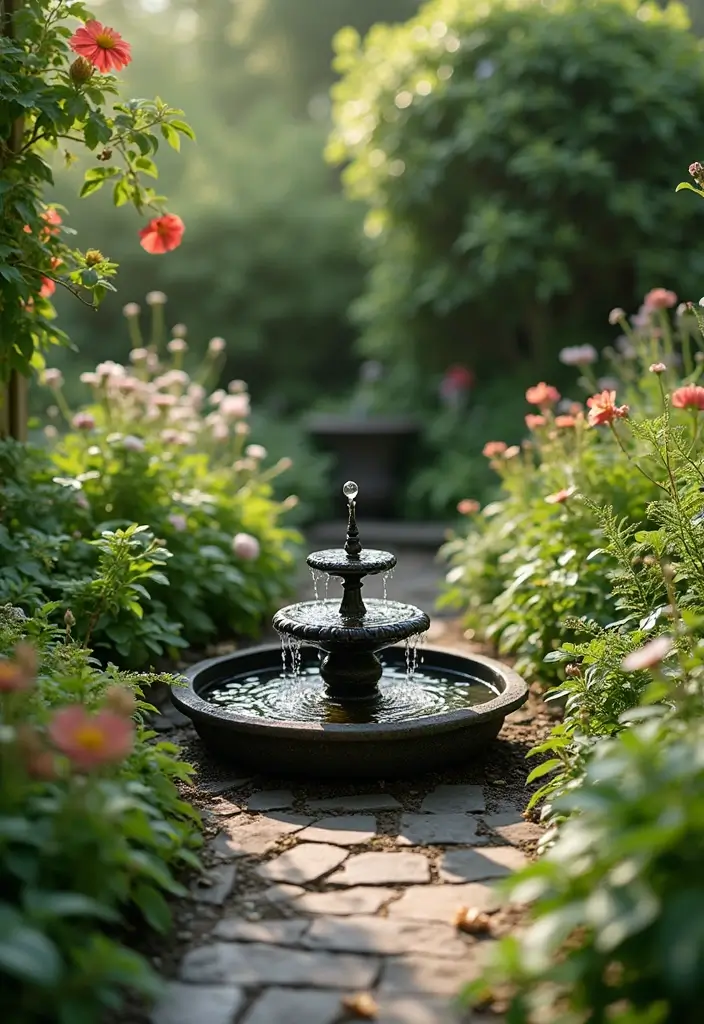
Adding a small water feature to your garden can create a peaceful oasis that enhances the sensory experience of your outdoor space. Consider options such as a tiny pond, a fountain, or a simple birdbath that welcomes wildlife. For example, the solar fountain pump kit is a great choice for creating a charming fountain in your garden or pond. It’s an easy-to-install solar-powered option that adds a soothing sound and attracts birds and butterflies, enhancing the tranquil atmosphere.
You can also incorporate a stylish decorative birdbath that not only serves as a beautiful focal point but also invites feathered friends to your garden. This vintage decorative birdbath features a trellis and can support climbing plants, adding more green to your space while providing water for wildlife.
To enhance the visual appeal of your water feature, consider adding aquatic plants. The aquatic plants for ponds—like live aquarium red root floaters—are easy to maintain and improve water quality. They not only contribute to a beautiful aquatic environment but also help filter the water, making your small pond healthier for local wildlife.
These features not only provide a calming sound that drowns out city noise, but they also transform your garden into a serene retreat, enhancing your enjoyment and connection with nature. Just ensure that any water features you choose are easy to maintain and positioned where you can easily enjoy them.
22. Pillar Gardens: Vertical Aesthetics
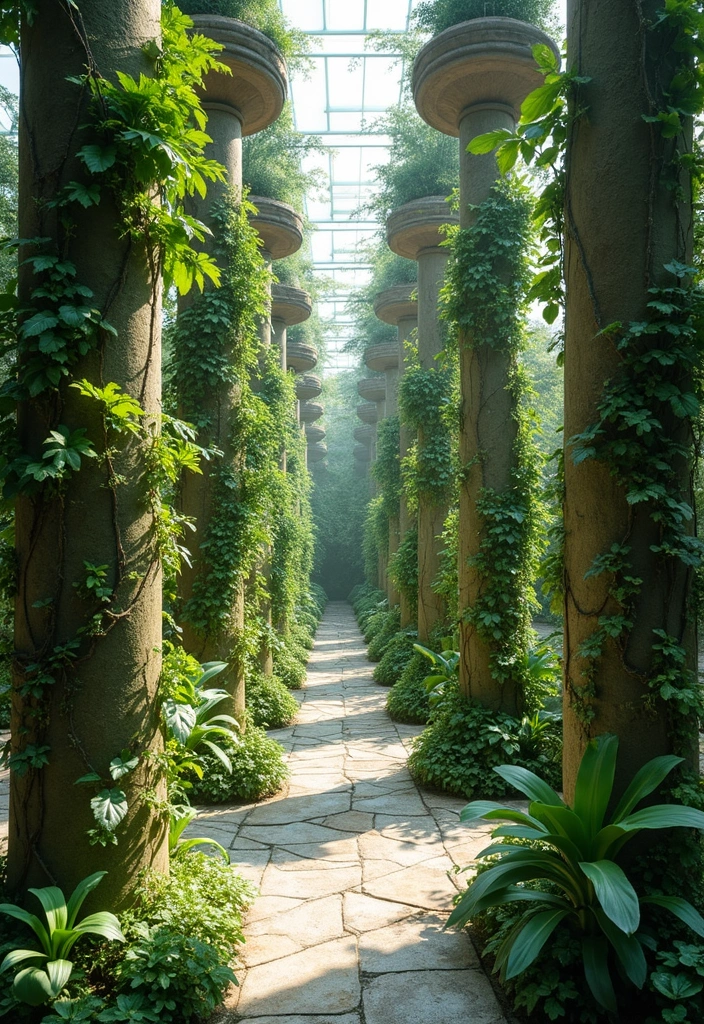
Elevate your garden design with pillar gardens, which utilize vertical space creatively. By using columns or posts, you can create stunning displays of plants that drape down or climb up, adding a unique aesthetic to your small space. For instance, consider using a garden pillar trellis. Standing at 5.6 feet tall, this lightweight trellis is perfect for supporting vining plants while enhancing the visual appeal of your outdoor area.
Pillar gardens are ideal for growing vining plants or cascading flowers, offering an eye-catching focal point. Not only do they make your garden feel larger, but they also add dimension and interest. To complement your creations, think about incorporating the vining plants seed pack. With 1000 seeds of hardy, drought-tolerant flowers like Billy Button, you’ll have vibrant blooms that thrive in vertical growth conditions, making your pillar garden even more striking.
Additionally, consider using hanging planters for an extra layer of beauty. These self-watering hanging baskets can be easily suspended from your columns, allowing you to mix trailing vines with colorful flowers for a stunning display.
Utilizing pillar gardens can transform your gardening experience, inviting creativity and beauty into your outdoor space. Remember to ensure that your pillars or columns can support the weight of growing plants for optimal results.
23. Seasonal Color Schemes: Design with Purpose
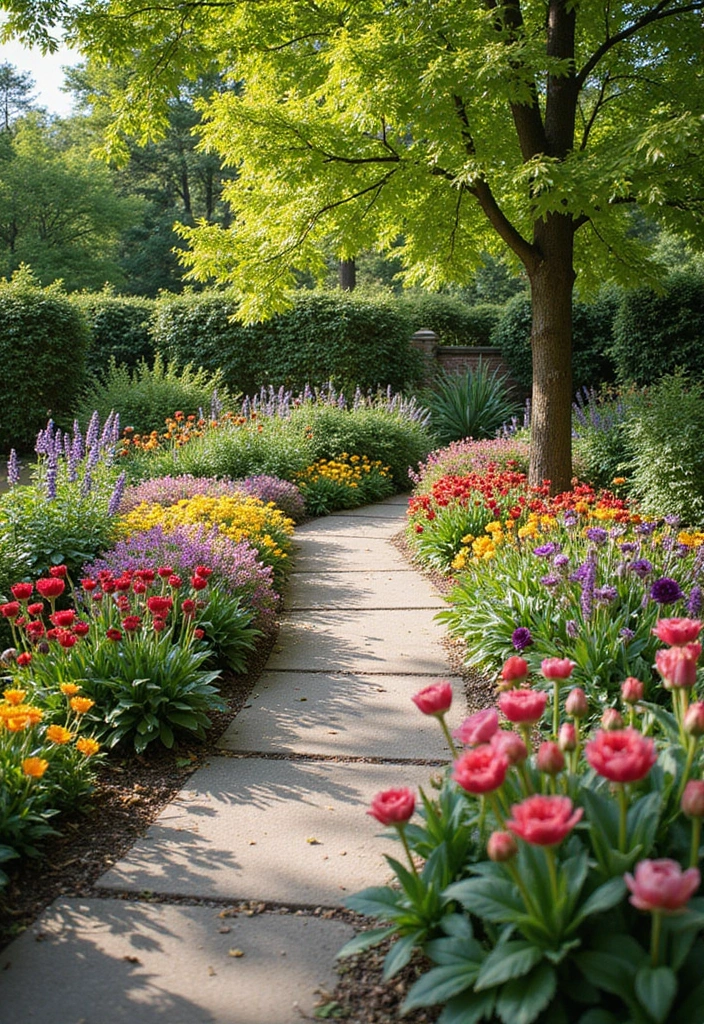
Designing your small garden with seasonal color schemes can bring harmony and beauty throughout the year. By choosing plants that bloom at different times, you can create a garden that bursts with color from early spring to late fall.
Mix annuals and perennials for continuous blooms. For spring, consider tulips and daffodils; in summer, think daisies and marigolds; in fall, add asters and chrysanthemums. This planning will keep your garden vibrant and lively. To help you effectively plan your plant placements according to their blooming times, a helpful resource is the Garden Planting Guide Book. This guide offers valuable insights into how to select and arrange your plants for maximum seasonal impact.
Additionally, incorporating foliage plants that provide color even when flowers are not in bloom adds depth to your garden. To create exciting color combinations, consider using a Garden Color Wheel. This tool will inspire you to experiment with different hues and textures, ensuring a dynamic landscape.
Regularly assessing your garden for seasonal adjustments is also essential to maximize color. Seasonal color schemes not only beautify your garden but enhance your outdoor space, creating a dynamic landscape that delights the senses.
24. Compost Bins: Sustainable Gardening
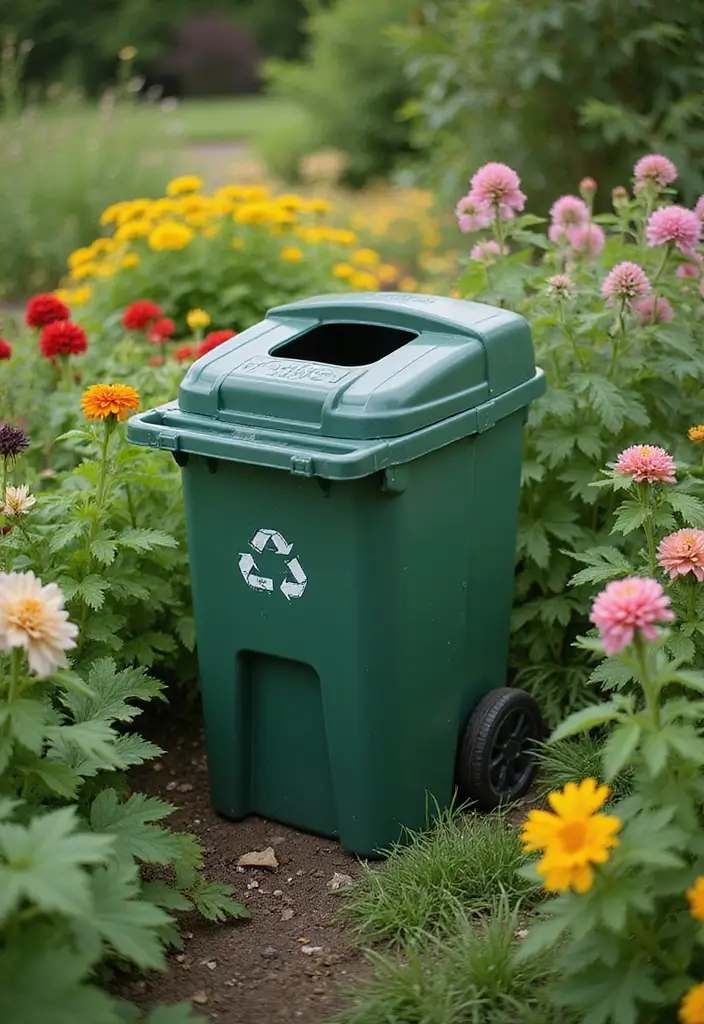
Incorporating a compost bin in your small garden can enhance its sustainability while providing nutrient-rich soil for your plants. Composting kitchen scraps and garden waste allows you to recycle while creating a valuable resource for your garden.
For a compact option that fits your space perfectly, consider the Utopia Kitchen compost bin for kitchen countertop. This 1.3-gallon compost bucket includes a lid and a spare charcoal filter, making it an ideal choice for collecting food scraps without unpleasant odors.
To ensure your compost breaks down efficiently, regular aeration is key. The EJWOX stainless steel compost aerator tool will help you mix and turn your compost, promoting faster decomposition and preventing clumps. This rust-proof manual tool is a practical addition to your composting routine.
When it comes to collecting scraps, using compostable kitchen bags can simplify the process. The UNNI compostable trash bags are extra thick and designed to fit small kitchen food scrap bins. Certified by BPI and CMA, they meet the ASTM D6400 standard, ensuring you’re contributing to a greener planet.
With time and these helpful tools, you’ll have rich compost that can be used to enrich your garden beds or container plants, allowing you to contribute positively to the environment while also improving your garden’s health.
Gardening Tips:
– Balance green (nitrogen-rich) and brown (carbon-rich) materials for effective composting.
– Regularly turn the compost for even decomposition.
– Keep it moist but not wet for the best results.
25. Create a Theme: Garden with Identity
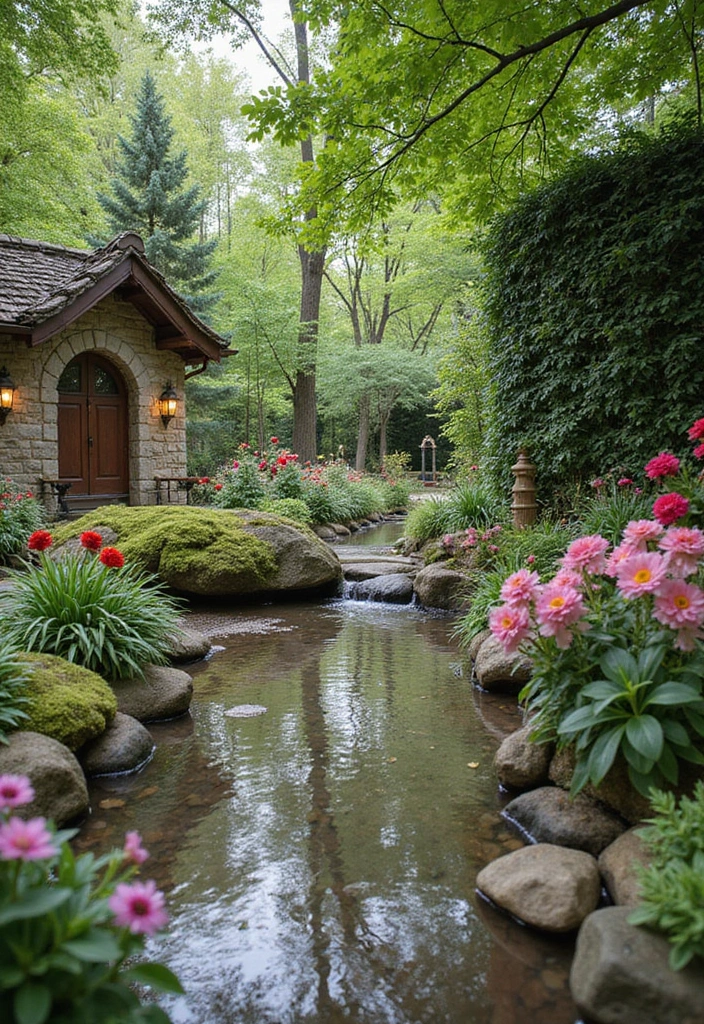
Consider creating a themed garden that reflects your personality or interests. Whether it’s a fairy garden, a zen retreat, or a cottage garden, having a theme creates coherence and can make planning and planting easier.
Incorporate unique elements that fit the theme, such as whimsical decorations like a solar happy cat outdoor statue garden decor, which adds a playful touch to a fairy garden. For a zen space, you might consider a water feature such as the Alpine Corporation rustic 2-tiered barrel and pump water fountain, providing a calming ambiance with its relaxing water flow. This approach not only enhances visual appeal but also makes your garden a personal haven.
If you’re leaning towards a fairy garden theme, a fairy garden kit with miniature figurines and accessories can help you create a magical atmosphere that showcases your creativity.
Gardening Tips:
– Keep your theme in mind when selecting plants and decor.
– Use focal points such as statues or water features to tie everything together.
– Regularly refresh your theme as seasons change.
Creating a themed garden allows you to express yourself while cultivating a unique outdoor space.
26. Garden Art: Personal Touches
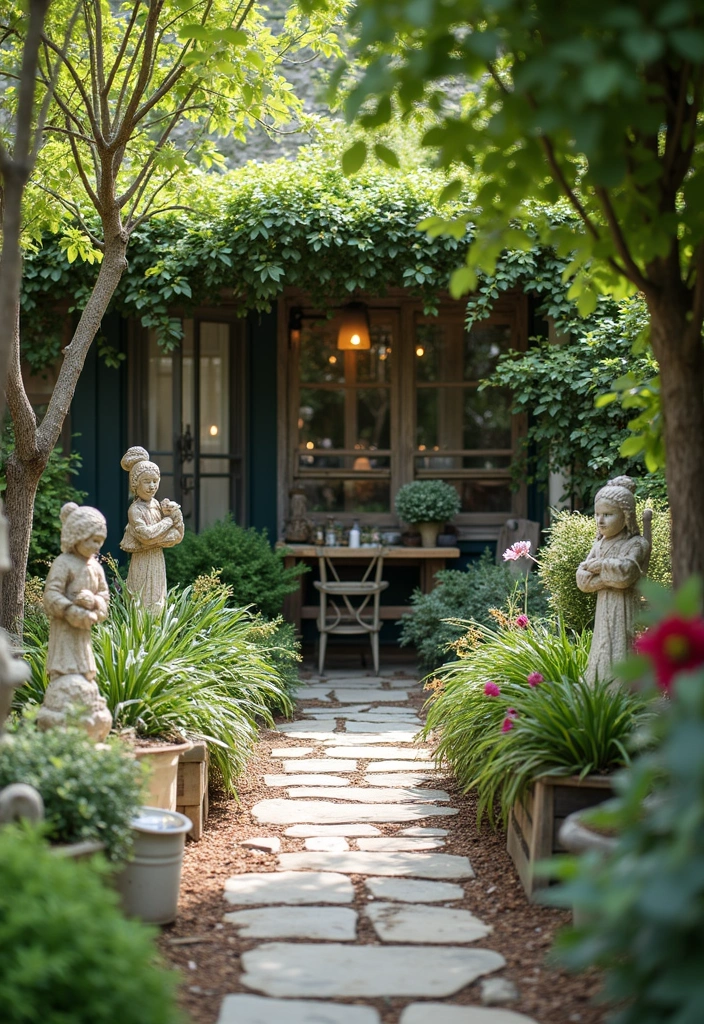
Incorporate unique garden art to express your creativity and enhance your small garden’s charm. From handcrafted sculptures like the handcrafted garden sculptures featuring oversized blue herons to vibrant painted stones, decorative pieces can bring personality and joy to your outdoor space. Consider creating art that resonates with your interests—using products like the painted garden stones from Creative Roots allows you to paint your own designs, making it a fun activity that adds a personal touch to your garden.
Wind chimes, such as the wind chimes with soothing melodic tones, can enhance the atmosphere of your outdoor space while providing a delightful sound. These elements can serve as conversation pieces while complementing your plant arrangements.
Gardening Tips:
– Choose art pieces that can withstand outdoor elements.
– Ensure your art complements the colors and style of your plants.
– Arrange art strategically for visual interest without overcrowding.
By adding garden art, you can transform your gardening experience into a vibrant display of your personality and style.
27. Miniature Garden Spaces: Create Small Worlds
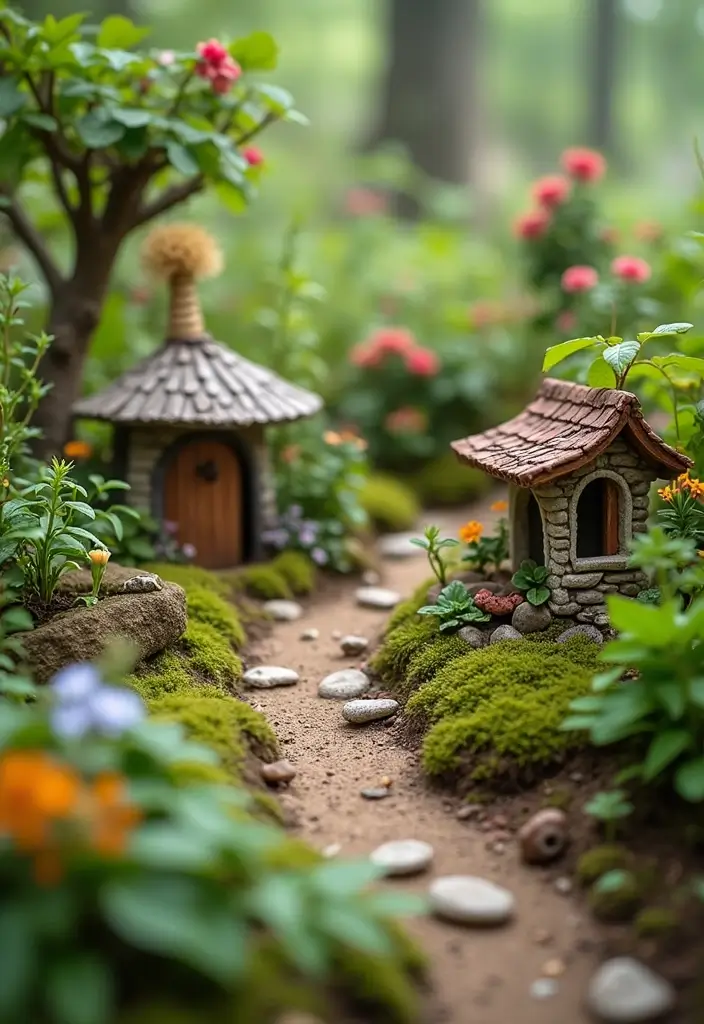
Miniature gardens are a delightful way to express creativity in a compact form. These tiny worlds can be crafted in containers or small garden beds, featuring mini plants, figurines, and decorative elements that enhance your outdoor space. They allow for endless imaginative possibilities!
To create your miniature garden, choose a theme, such as a fairy garden or a tiny vegetable patch, and gather miniature accessories to fill your space. For instance, the miniature garden accessories set includes seven charming resin figures, such as squirrels and hedgehogs, along with acorns and mushrooms, perfect for adding a whimsical touch to your garden.
Next, consider using the miniature plants variety pack, which features 100 pieces of mini trees, flowers, and shrubs. These tiny plants are well-suited for your theme, whether you’re crafting a fairy garden or a scenic diorama. Incorporating these elements helps create a lush, vibrant environment.
Don’t forget about the containers! The container for miniature garden, an 8-pack of ceramic pots, is ideal for housing your mini succulents and flowers in a visually appealing way. These pots are designed for 1:12 scale, ensuring that everything fits perfectly within your miniature world.
Regularly caring for your miniature garden will keep it looking fresh and inviting, bringing joy to anyone who encounters it. Creating miniature garden spaces invites creativity and offers a playful twist to traditional gardening.
28. Dream Garden Journal: Track Your Growth
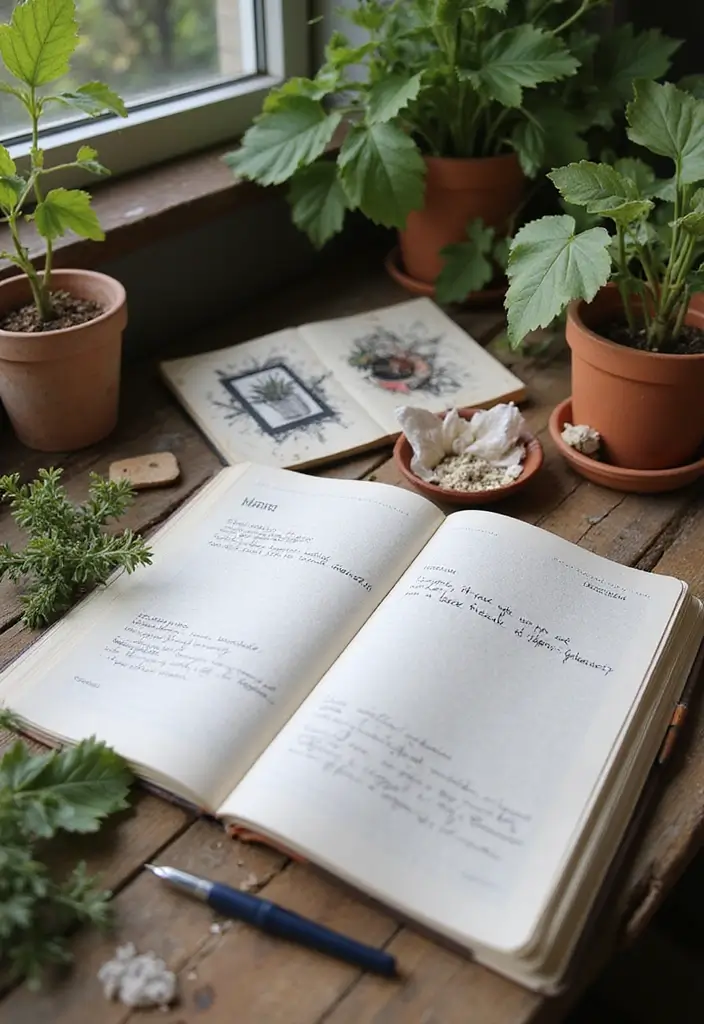
Start a dream garden journal to track your gardening progress and plan future projects. This tool can help you visualize your garden, jot down ideas, and reflect on what’s working or not. You might consider using a Clever Fox Gardener’s Journal, which is a guided gardening notebook designed for planting vegetables, flowers, and herbs over five years. It’s perfect for beginners who want to keep a detailed log of their gardening journey.
Include sketches, seasonal checklists, or even photographs of your plants as they grow. A Spring Gardening Sketchbook with 100 pages of plain sketchbook paper is ideal for sketching and logging new plants. It’s an engaging way to stay connected with your garden and learn from your experiences.
Gardening Tips:
– Set aside time each week to update your journal.
– Note down any challenges or successes for future reference.
– Use your journal as motivation to experiment with new plants and ideas.
Additionally, consider checking out 40 Projects for Building Your Backyard Homestead, which includes seasonal gardening checklists and hands-on projects for sustainable living. A dream garden journal enriches your gardening experience, helping you grow alongside your plants and achieve your outdoor aspirations.
Conclusion: Cultivating Your Small Garden Dreams
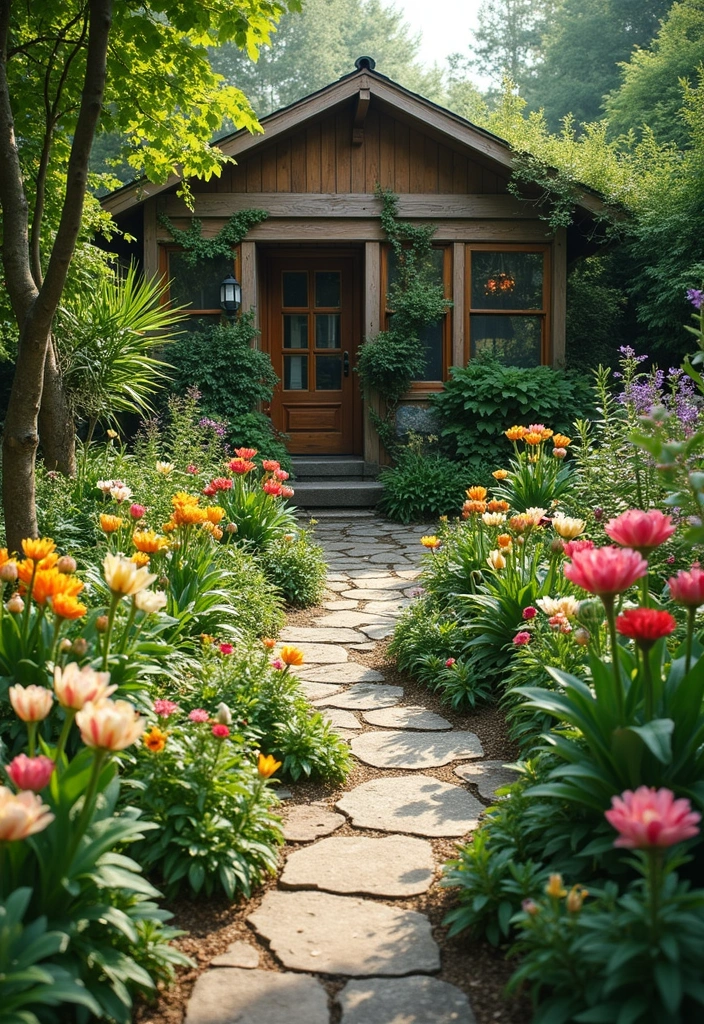
Maximizing a small garden isn’t just about the space you have; it’s about creativity and the joy of gardening. With each of the 28 ideas shared, you can transform even the coziest corners into lush, vibrant havens. Remember that every plant tells a story, and your garden is a reflection of your personality.
By embracing seasonal gardening, you’ll enjoy the magic of growth, beauty, and harvest all year long. Whether it’s through crafting, planting edible landscapes, or creating cozy nooks, your small garden can be a source of pride and joy. So grab your gardening gloves and get started on your own little paradise!
Note: We aim to provide accurate product links, but some may occasionally expire or become unavailable. If this happens, please search directly on Amazon for the product or a suitable alternative.
This post contains Amazon affiliate links, meaning I may earn a small commission if you purchase through my links, at no extra cost to you.
Frequently Asked Questions
What Are Some Effective Small Garden Ideas for Limited Outdoor Spaces?
When space is tight, consider options like vertical gardens and container planting. Vertical gardens let you grow a variety of plants upwards, saving ground space, while container planting offers flexibility to arrange pots wherever you like! Both methods can maximize beauty and productivity in your small garden.
How Can I Incorporate Seasonal Vegetables into My Small Garden?
Seasonal planting is key for a vibrant garden year-round! Choose vegetables that thrive in your area during specific seasons. For example, leafy greens in cooler months and tomatoes in warmer months can keep your garden productive. Rotate your crops to make the most of your space and enjoy fresh veggies throughout the year!
What Are Some Gardening Tips for Beginners with Small Gardens?
If you’re new to gardening, start simple! Focus on easy-to-grow plants like herbs or succulents that require less care. Opt for raised garden beds for better soil quality and accessibility. Also, keep a garden journal to track your plants’ progress and learn what works best in your small garden!
How Can I Create a Relaxing Atmosphere in My Small Garden?
Transform a cozy corner into a charming seating area! Use simple chairs or benches and surround them with fragrant flowers and lush greenery. Adding elements like small water features or garden art can enhance the ambiance, making your small garden a perfect retreat for relaxation.
What Are the Benefits of Using Herb Spirals in Small Gardens?
Herb spirals are a fantastic way to maximize space while growing various herbs! This unique design creates different microclimates, allowing you to cultivate herbs that require different conditions all in one spot. Plus, they add a stunning visual element to your garden while making it easy to access fresh herbs for cooking!
Related Topics

